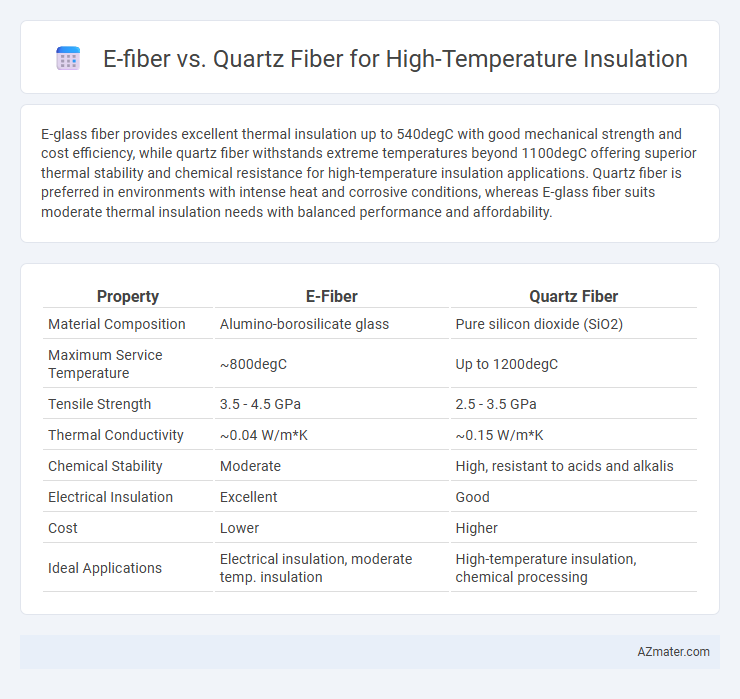E-glass fiber provides excellent thermal insulation up to 540degC with good mechanical strength and cost efficiency, while quartz fiber withstands extreme temperatures beyond 1100degC offering superior thermal stability and chemical resistance for high-temperature insulation applications. Quartz fiber is preferred in environments with intense heat and corrosive conditions, whereas E-glass fiber suits moderate thermal insulation needs with balanced performance and affordability.
Table of Comparison
| Property | E-Fiber | Quartz Fiber |
|---|---|---|
| Material Composition | Alumino-borosilicate glass | Pure silicon dioxide (SiO2) |
| Maximum Service Temperature | ~800degC | Up to 1200degC |
| Tensile Strength | 3.5 - 4.5 GPa | 2.5 - 3.5 GPa |
| Thermal Conductivity | ~0.04 W/m*K | ~0.15 W/m*K |
| Chemical Stability | Moderate | High, resistant to acids and alkalis |
| Electrical Insulation | Excellent | Good |
| Cost | Lower | Higher |
| Ideal Applications | Electrical insulation, moderate temp. insulation | High-temperature insulation, chemical processing |
Introduction to High-Temperature Insulation Materials
High-temperature insulation materials like E-fiber and quartz fiber are critical for protecting equipment in extreme thermal environments. E-fiber offers excellent electrical insulation and moderate thermal resistance up to around 540degC, making it suitable for applications requiring lightweight and durable thermal barriers. Quartz fiber withstands higher temperatures, often exceeding 1100degC, providing superior thermal stability and chemical resistance for industrial processes involving intense heat exposure.
Overview of E-Fiber and Quartz Fiber
E-fiber, a type of glass fiber primarily composed of alumino-borosilicate, offers excellent thermal resistance up to temperatures around 540degC, making it suitable for general high-temperature insulation applications. Quartz fiber, made from nearly pure silicon dioxide, withstands extremely high temperatures exceeding 1,100degC and provides superior thermal stability and chemical resistance. Both fibers are essential in insulation, with E-fiber favored for cost-effective moderate heat environments and quartz fiber preferred for ultra-high-temperature and chemically aggressive conditions.
Chemical Composition and Structure
E-fiber, composed primarily of alumino-borosilicate glass with a high content of silicon dioxide (SiO2), boron oxide (B2O3), and aluminum oxide (Al2O3), offers excellent thermal stability and electrical insulation for high-temperature applications up to 550degC. Quartz fiber consists almost entirely of pure silicon dioxide (SiO2) with a highly crystalline structure that enables outstanding resistance to chemical corrosion and thermal expansion at temperatures exceeding 1200degC. The amorphous structure of E-fiber contrasts with the crystalline lattice in quartz fiber, influencing their thermal insulation performance and mechanical durability in extreme environments.
Thermal Stability and Heat Resistance
E-fiber offers excellent thermal stability with continuous use temperatures up to 540degC, making it suitable for general high-temperature insulation applications. Quartz fiber, however, provides superior heat resistance with operational limits exceeding 1100degC and exceptional thermal stability due to its pure silica composition, ensuring minimal structural degradation under extreme thermal stress. These properties position quartz fiber as the preferred material for advanced insulation in environments demanding prolonged exposure to ultra-high temperatures.
Mechanical Strength and Durability
E-fiber offers superior mechanical strength with tensile strengths typically around 3.4 GPa, making it suitable for applications requiring high load-bearing capacity, but its performance deteriorates above 540degC. Quartz fiber exhibits exceptional durability and thermal stability, maintaining structural integrity at temperatures exceeding 1100degC, though it generally has lower tensile strength near 1.5 GPa. For high-temperature insulation, quartz fiber is preferred in environments demanding sustained thermal resistance, while E-fiber is advantageous when higher mechanical strength at moderate temperatures is required.
Insulation Performance at Elevated Temperatures
Quartz fiber exhibits superior insulation performance at elevated temperatures compared to E-fiber, maintaining structural integrity and dielectric properties beyond 1000degC. E-fiber insulation is typically limited to temperatures below 600degC due to its lower melting point and susceptibility to oxidation. Quartz fiber's high thermal stability and low thermal conductivity make it ideal for applications requiring durable electrical insulation in extreme thermal environments.
Resistance to Chemical Corrosion
E-fiber exhibits moderate resistance to chemical corrosion but tends to degrade under exposure to strong acids and alkalis, limiting its effectiveness in highly corrosive environments. Quartz fiber demonstrates exceptional chemical resistance, maintaining structural integrity and insulation performance even in aggressive acidic or alkaline conditions at elevated temperatures. This makes quartz fiber the preferred choice for high-temperature insulation applications requiring superior durability against chemical corrosion.
Cost-Effectiveness and Availability
E-fiber offers a more cost-effective solution for high-temperature insulation due to its lower manufacturing expenses and widespread industrial availability. Quartz fiber, though superior in extreme thermal resistance and chemical stability, commands higher costs and limited supply, restricting its use to specialized applications. Industries prioritize E-fiber for routine insulation needs where budget constraints and material accessibility are critical factors.
Applications in Industry and Technology
E-fiber offers superior strength and cost-efficiency in high-temperature insulation applications, making it ideal for automotive heat shields and electrical cable insulation. Quartz fiber provides exceptional thermal stability above 1000degC, essential for aerospace components, semiconductor manufacturing, and industrial furnace linings. Industries requiring extreme heat resistance prioritize quartz fiber for its durability and chemical inertness, while E-fiber suits mass-market uses where moderate thermal tolerance suffices.
Choosing the Right Fiber: E-Fiber vs Quartz Fiber
E-fiber and quartz fiber are two prominent options for high-temperature insulation, each with distinct properties that influence their application. E-fiber, composed primarily of alumino-borosilicate glass, offers excellent thermal resistance up to approximately 1100degC and superior electrical insulation, making it suitable for medium-high temperature environments. Quartz fiber withstands temperatures exceeding 1200degC due to its high purity silica content, providing exceptional thermal stability and low thermal expansion, making it ideal for extreme high-temperature insulation where durability and minimal shrinkage are critical.

Infographic: E-fiber vs Quartz fiber for High-Temperature Insulation
 azmater.com
azmater.com